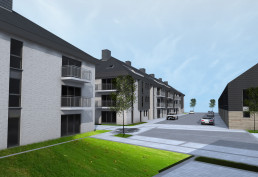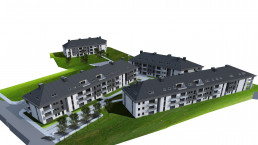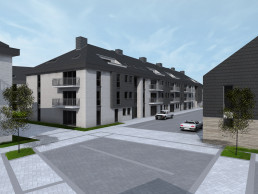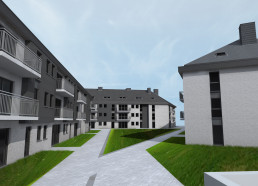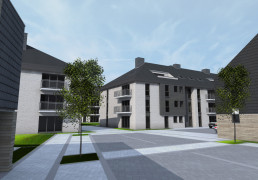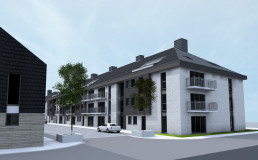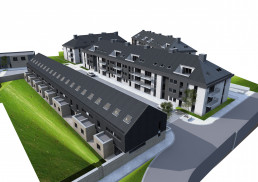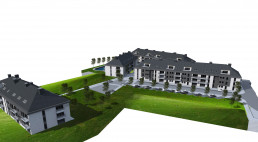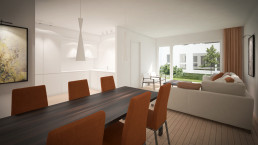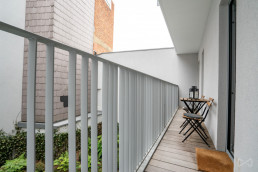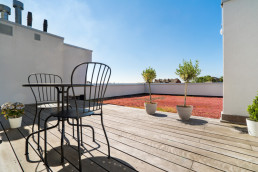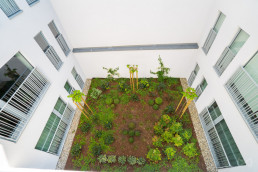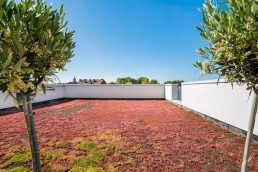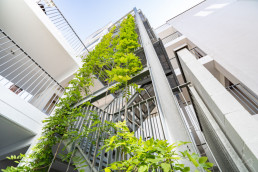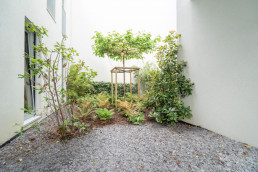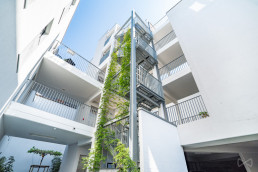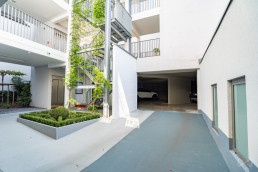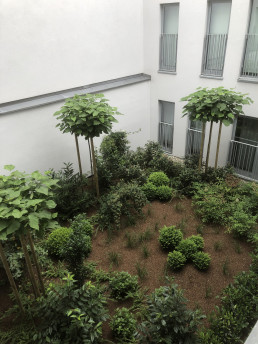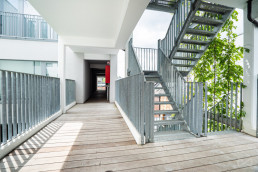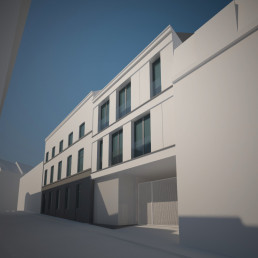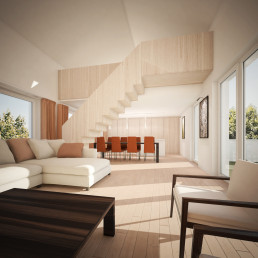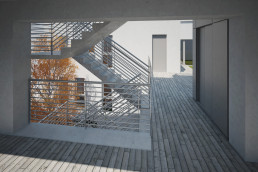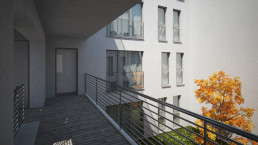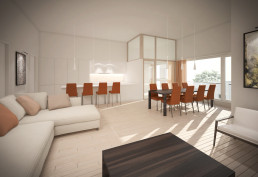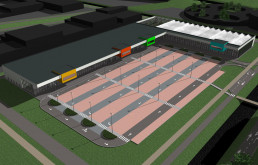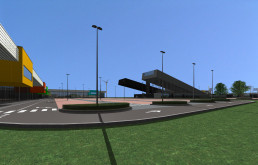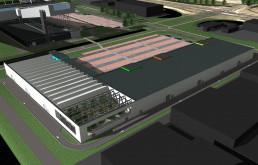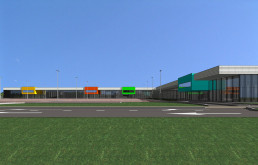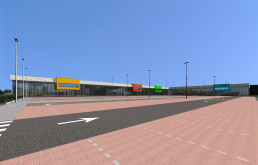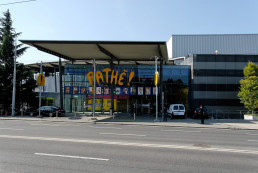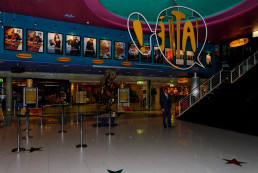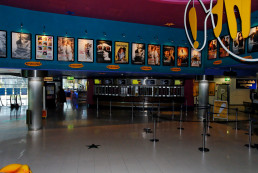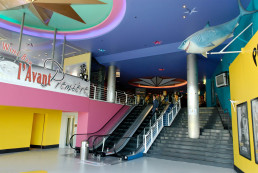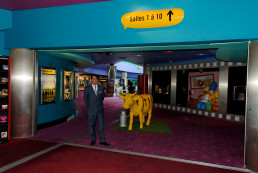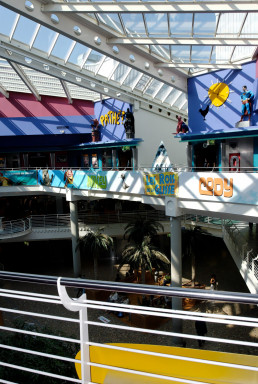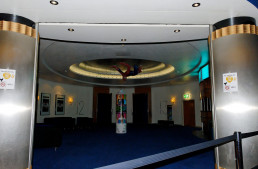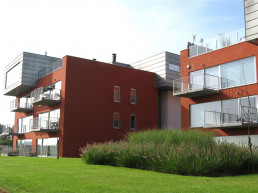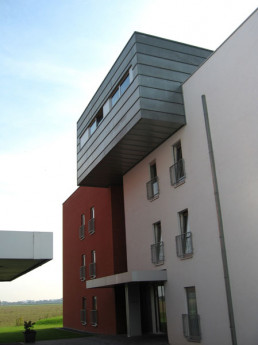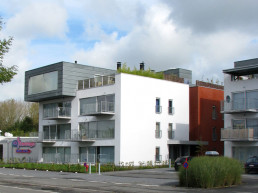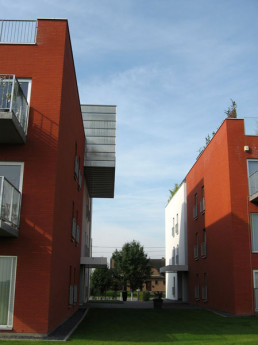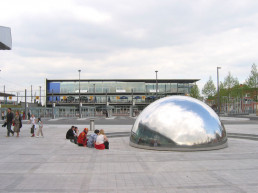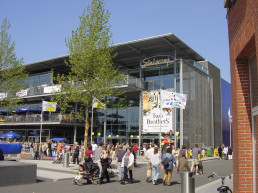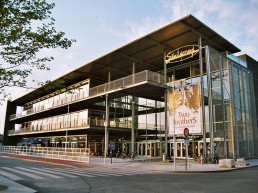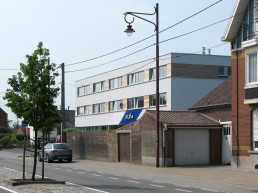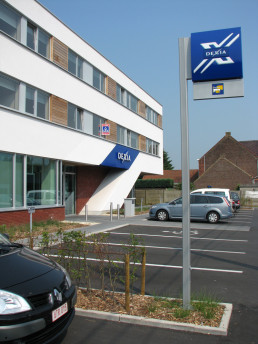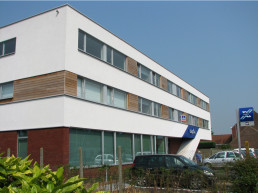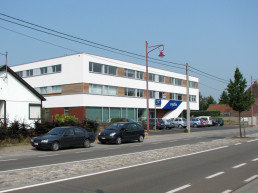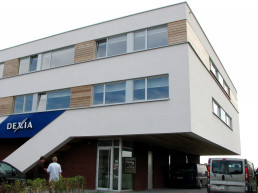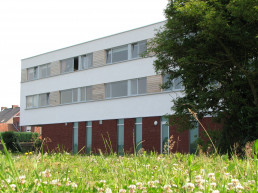Residence Gabriel
Residence Gabriel
The city of Nivelles is centrally located between Brussels, La Louvière and Charleroi. It lies downstream from the surrounding countryside in the province of Walloon Brabant. At 30 minutes from Brussels, Nivelles is a good alternative living location for people who find their employment in the relatively expensive Brussels metropolitan area. It offers a wide range of services and leisure activities thanks to its shopping mall inaugurated in 2012 and its restaurants, pubs and shops located in the centre and in the south of the city.
THE PROJECT ‘RESIDENCE GABRIEL’
Project ‘Résidence Gabriel’ is born from the desire of a Nivellois architect and Health Invest to create a new harmonious living space in downtown Nivelles, combining heritage and contemporary architecture in a comfortable surrounding.
This project is part of architectural initiatives that aim to promote the city centre, giving the possibility to people to reintegrate into the urban heart of downtown dynamics. Located on Place Delalieux, the architectural ensemble spread over two floors will, after renovation with high quality durable materials, consist of six one and two-bedroom housing units. This diversity responds to the concern to host multiple ways to live and to ensure maximum opportunities that meet current living standards. Two commercial units on the ground floor with a total surface encompassing 350 m² will complete the project.
The orientation of the front and rear panel offer a panoramic view of the Place Delalieux. The main feature of the project is to improve the aesthetics of the existing premises and to create a homogeneous ensemble.
The last project plan below:
Information:
Mr.Olivier Mathurin
Immobiliere Sogefi
Square Gabreille Petit 5
1400 Nivelles
Tel: 067/ 213 006
Mobile: 0479/ 214 127
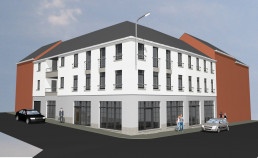
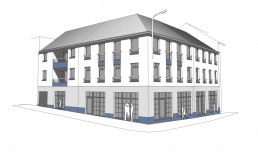
Les Rives Montoises
Les Rives Montoises
The “LES RIVES MONTOISES” housing project is being constructed in the area known as “Les Grands Prés”, to the south-west of Mons. The location is wholly surrounded by woodlands and can be easily reached by means of a side street of the N6, which is the major linking road between Mons and its southern hinterlands. The project fulfils the demand for social, but still attractive and affordable, housing alongside the major roads leading into Mons. It includes apartments that are being offered to the general public.
The project covers over 1.5 hectares and includes 1, 2 and 3 bedroom apartments, all of which meet the required social standards. The habitable areas of the apartments are as large as possible, as areas for communal facilities, such as staircases and corridors, have been minimised as far as possible. The diversity of choice with regard to the apartments will lead to the socio-cultural enrichment of the area, given that every family – those with children and without – can feel at home in this new suburb that is linked to existing urban areas.
In laying out “LES RIVES MONTOISES”, special attention has been paid to the common green areas, giving the inhabitants a feeling of safety and security and contributing to the social control, which is indispensible to the local quality of life. Trees and woodlands that have had to make way for the construction project have been replanted in those public green areas.
The infrastructure has been optimally designed for all road-users, be they pedestrians, cyclists or drivers. The Rue du Curoir links the housing project’s roads to existing ones while, in order to optimise space, the local road network has been kept to a minimum without accessibility being restricted (in particular when it comes to access for the emergency services). The underground parking guarantees that the suburb is free of the visual impediment of cars, which is a great benefit to the quality of life.
Namur Station
Namur Station
Namur is the capital of the Belgian region of Wallonia and seat of the Walloon public institutions. Plans are in place to redevelop Namur so that it can do justice to its city status. The station and surrounding area – the hub for transport links to the outside world – plays a key role in this makeover.
Architecturally, the plan is expressed through the use of a modern design, contemporary materials and a pure composition. The proposed design gives the station the look that its social role demands and turns it into a true centrally-located orientation point in the city. The point of departure adopted in including the building in the area’s urban development plans is one of architectural antitheses.
This contrast in architectural expressions (the classical station and the modern MET building and platform) guarantees the positive re-evaluation of the urban quality – a position confirmed by the Leuven station, with the contrast between the old station building and the new platform awning serving as an excellent example of this aspect.
The general cityscape is echoed by “metal waves”, which serve to extend the existing morphology and design. These waves refer to the station’s archetype, the glass vault and the dome.
Le Corso Apartments in Mons
Le Corso Apartments in Mons
MONS – THE TOWN
Less than one hour away from Lille and Brussels, and only one hour thirty minutes from Paris, Mons is a cross-border town in a highly strategic position. Featuring all the advantages of a modern town, Mons offers its residents an exceptional quality of life, with a wide range of services and leisure activities, while retaining a warm and friendly human dimension.
LE CORSO’ PROJECT
The ‘Le Corso’ project was born out of the desire of the town of Mons and the company Health Invest to create a harmonious new living space in the historic town centre that perfectly entwines heritage, contemporary architecture and cutting-edge fittings and finishings.
Le Corso is an architectural project that aims to enhance the town, allowing its inhabitants to integrate into the creative dynamic of the urban fabric at the heart of Hainaut’s capital.
Located on the site of the former Montois cinema, the building comprises seventeen different homes, from studio flats to one and two bedroom apartments. This diversity responds to a wish to accommodate a variety of lifestyles, and to satisfy the greatest number of expectations concerning the current energy quality standards. The project is complemented by fourteen parking spaces.
The apartments have large windows at the rear that benefit from an ideal source of natural sunlight and a scenic view over the enclosed garden. Each apartment has been finished to a high-standard and in a neutral manner for future homeowners to adapt to their own individual taste. The project’s most outstanding features are the numerous green spaces on each floor and its large internal planted patio.
Plans of the units
Transformation of the former ‘Corso’ cinema into a block of 17 apartments with parking spaces on a plot covering rue des Capucins, 7 and rue de Dinant, 3, 5, 7A, 7B and 9 in 7000 MONS
CLICK ON THE LINK BELOW FOR AN EXPLANATORY NOTE FROM THE ARCHITECT:
PRESENTATION OF THE PROJECT BY THE ARCHITECT
– The information and images may be modified at any time.
– This document is sent for information purposes only and does not constitute a commitment of any sort.
– Non-contractual document.
CORSO: COMMERCIAL SPECIFICATIONS
External features
At ground level, the floor covering consists of Klinker interlocking pavers with a cement border. The green spaces are laid with turf and planted with low regional trees.
On the upper levels, the flooring of the entrance passageways is made of exotic wood on a galvanised steel structure. The staircases and handrails are made of galvanised steel. The electric traction lift is very quiet, energy-efficient and fast.
The external cladding of the (newly built and existing) buildings is made of a light-coloured mineral render (white or very light grey, to be decided). The external window and door frames are made of a mid-grey PVC or aluminium (to be decided), with double-glazing (according to the Building Energy Efficiency standard (PEB) in force in Belgium). The door and window openings are shown in the plans. The roof windows are VELUX or similar, with a pivot opening of a least 120°.
The sloping roofs are insulated (according to the Building Energy Efficiency standard in force in Belgium), and covered with anthracite-coloured synthetic slate tiles. The flat roofs of the building are extensive green roofs.
Underground parking
The internal walls and ceilings of the underground car park are painted a very light grey. The floor is of cement with very clear markings. The entrance gates are sliding or sectional with openwork railings. Each homebuyer with an underground parking space will receive an automatic control for the shared gates. The ventilation is natural and continuous.
The common areas
The internal walls of the common areas are plastered and painted. The ceilings are covered with thin plaster and painted. The floor covering and skirting boards made of glazed ceramic stoneware are chosen by the developer. The colour palette will be defined according to the design and special decorating plan drawn up by the architect. The rooms concerned are located along the entrance porch and include the technical rooms and the bicycle storage room. The various models of doors, door frames, embrasures and door fittings have been chosen by the Developer to comply with the fire regulations.
The private areas
The choice of both the materials and fittings in these superb turnkey apartments is to a high standard (including fitted kitchen, fitted bathroom, and intercom system). In terms of energy efficiency, the apartments meet the standards that were in effect on the date when the planning permission request was submitted (June 2013).
The walls separating the apartments are made of solid sand-lime blocks or similar. The internal partition walls are smooth ‘ready to paint’ plaster blocks. The coatings on the roof slopes, wooden beams and lightweight partitions under the roof slopes are made of RF60 plaster panels pursuant to the Regional Fire Service regulations. In the living areas (sitting rooms, kitchens, halls, night halls, bedrooms and offices), wood is the chosen floor covering (oak for a luxury finish, or bamboo, for a comfortable finish). The bathroom and toilet floors are covered in marble or travertine (the buyer may choose). The technical rooms (storage and utility rooms) are tiled with a ceramic stoneware coating (synthetic travertine). The bathroom walls are fully tiled to complement the chosen floor covering. The indoor woodwork is painted in white tones and have the same type of embrasures and door frames.
The ventilation system is of a centralised and individual dual-flow type. Each apartment has its own individual control unit. The ventilation complies with current regulations and has been fitted according to the recommendations of the Building Energy Efficiency manager. The heating is provided by individual gas boilers. The radiators are sized and positioned to suit each individual room. The radiators have been installed to meet current standards and according to the recommendations of the Building Energy Efficiency manager.
Latest information:
cdc commercial 17-01-2017 (PDF)
CONTACT
Mme Ilona Esther Sekula
Health Invest SA
Industrieweg 3
2880 Bornem
+32 (0)476 60 65 37
+32 (3)890 91 11
info@healthinvest-beherman.com
Project Koegorspolder Terneuzen second phase
Project Koegorspolder Terneuzen second phase
Property developer Olivier Beherman of Health Invest has submitted a plan to the Terneuzen municipality for developing the second phase of the northern Koegorspolder. Beherman hopes to construct a 9,750 m2 large-scale retail centre to the east of the Skidôme winter sports centre, along with several hundred parking places. The retail centre will cost around 6.5 million euros to construct, and Beherman already has a guaranteed buyer. There has been particular market interest in creating a garden centre in the new facility.
Beherman, a property developer and owner of the Skidôme winter sports centre, had finalised the construction plan last year but was compelled to hold off because he first needed to find a new manager for the wintersportscenter, which happened last October when Rucphen entrepreneur Nicky Broos took over Skidôme. He vigorously set about recapturing the winter sports market on both sides of the Belgian-Dutch border.
The property developer is well-aware of the fact that the property he owns in Koegorspolder is still designated for agricultural use, and that there is a long road to travel for its re-designation. “But developments have not come to a standstill in Terneuzen either,” he says. “Work is progressing well on the new roads infrastructure required for the construction of the Sluiskil Tunnel. In the near future Koegorspolder will be the heart of Zeelandic Flanders, with connections to both Flanders and the Zeeland midlands. The area around the indoor ski slope will then be transformed into the urban fringe of Terneuzen, which means there will be many opportunities. And not taking advantage of them would, from the point of view of Terneuzen municipality, be very unwise indeed,” says Beherman.
The Belgian property developer is not alone in that view, with AVV Beheer Terneuzen, which owns over five hectares of land in Koegorspolder (previously the property of AM Wonen), likewise stating that the municipality must soon reach a decision on the development of the urban fringe. To date the Terneuzen municipality has only wanted to permit large-scale retail in the Kennedy-West planning area. Local authorities have been discussing that area’s development for years with Lafoma property developers and the construction company Van der Poel, but concrete plans have as yet never been presented.
Beherman believes that the Kennedy-West development is not feasible and the market has shown very little interest in it. “But for the Koegorspolder there is still interest, despite the setbacks we have encountered. Terneuzen will have to finally make a decision, and by submitting our plan – for which, for that matter, BAM Utiliteitsbouw has already put itself forward – we hope to convince the municipality that Terneuzen’s development potential lies to the city’s south. It is Terneuzen – and not the province of Zeeland – that is going to have to make a decision,” says Beherman.
Pathé Cinema Complex, Switzerland
Pathé Cinema Complex, Switzerland
The cosmopolitan area of Geneva is the smallest of the large financial metropolises in the world. It is a city where Olivier Beherman developed a cinema that fits into the fairytale Geneva.
The complex is now home to Pathé and houses 13 cinema screens. To complete the happiness of the visitor there is a restaurant and also a Mövenpick ice cream parlor.
Architect:
HR Lewis
Contractor:
Cosimco / B&E
Jurbise 1
Jurbise 1
The train station and the bus stop are within walking distance. The commercial features are found in the immediate vicinity of the residence (300 m). The volume of the building of 29 apartments with underground parking (20 spaces) meets the urban and contextual requirements. The residence is divided into two staggered blocks which mitigate the overall impression. The use of diverse materials, the alternatively implanted terraces and the cantilever penthouses give the composition of the facades a playful aspect. We have opted for natural and contemporary high-quality facade materials. The exterior joinery (windows and doors) is executed in aluminium, thermally broken, with double transparent glazing.
The choice of materials and the sobriety of the whole give the residence Remus and Romulus a personal presence in the environment and enhance the value of the apartments that have been designed and constructed on the basis of a well-considered functionalism. Their orientation to the sunshine and to the exterior views has also been studied carefully.
Station Sint-Niklaas
Sint-Niklaas Railways Station
Redevelopment of the Sint-Niklaas Railways station, a 24.000 m² area encompassing an 8-screen multiplex, a new shopping center and several eating facilities.
The project proved to be a successful Public-Private cooperation and transformed an unpleasant , rather bare space into a lively place in the heart of the city.
Skidôme Terneuzen
Skidôme Terneuzen
The indoor ski slope forms the main attraction of this broad multipurpose real estate development. The total land area for the ski slope, the retail centre and the parking accommodation encompasses 6 hectares. The site is located on the periphery of the city of Terneuzen, 200 meters south of the regional highway connecting Terneuzen to Ghent, Antwerp and Rotterdam.
Formula
A catalyst for growth in the leisure market is the emergence of new and exciting leisure venues. These new venues stimulate demand by creating attractive entertainment experiences in secure environments with accessible locations. The schemes are becoming larger and more sophisticated in terms of lay-out, scale and flexibility, being multi-facility venues providing diversity, variety and convenience. They collect together a mix of leisure uses, which may include elements of retailing and create a broad based customer appeal.
The leisure market has emerged in much the same way as the out-of-town retail. Both have progressed significantly since the first generation schemes of the early 90’s. These were often converted industrial buildings whereas the latest generation are ‘state of the art’ open parks. The market situation for the implementation of an indoor ski slope combined with a retail centre in Terneuzen has been assessed favorably for the following reasons:
- The growth of the leisure market in general. Simultaneously the market for mono-functional formulas has decreased;
- The broad operating formula of the retail centre whereby several target groups are reached;
- A large catchment area with a high population density on the Flemish side;
- There are no indoor ski slopes within the trade area and no large retail centres within the catchment area.
The building combines and integrates a large and coherent program of entertainment, sports and recreational retail activities. This synergy is achieved as follows:
- Synergy in Time: beside the ski slope as a trigger of this multipurpose development it is important that there is always an activity in the centre.
- Complementary Synergy: the ski slope is reinforced with leisure and retail activities that complement each other.
- Nourishing Synergy: food & beverage corners as well as large-scale retail activities stimulate the animation of the centre.
Market Factors
Commercial leisure has been a fast growing property sector in the 2000s. Rapid development has been driven by leisure spending which has outperformed growth in consumer expenditure and is expected to continue to do so over the medium term.
Several of the major operating companies in the leisure industry are reporting good trading results and are now developing those divisions which they consider to be faster growing. Scheme layouts and unit sizes continue to evolve as operators refine and improve their trading formats.
Changing demographics towards an increasingly affluent population, with a growing economic importance of women and an increasing propensity to spend on entertainment away from home, is helping to drive the market. Planning restrictions continue to curb out-of-town development, restrict supply and are expected to underpin values.
Location
The location of Terneuzen was chosen for the following reasons:
- Economic: Very strong economic potential that will enhance further by the development of the Canal zone Terneuzen-Ghent and the increasing interaction between the harbors of Antwerp, Ghent and Rotterdam. In the near future this area will become one large economic axis.
- Catchment area: Terneuzen lies centrally between the cities of Antwerp, Ghent and Bruges and hence embraces a large and wealthy population.
- Infrastructure and accessibility: good infrastructure, easy access to the site and a large free car park.
Operational results
The indoor ski slope opened its doors in July 2008. After several years of operations, the number of visitors continues to increase. Numerous regional companies are organizing events in the centre. Moreover the turnover of the Perry sports shop located in the centre has outperformed the other Perry shops in the Netherlands by achieving the highest turnover per m².
Future developments
The whole site has a gross surface of 520.000 m². Health Invest owns and controls 180.000 m². In a second phase Health Invest plans to proceed the development of the site by envisaging a large garden and do-it-yourself (DIY) centre for the whole region.
Jurbise 2
Jurbise 2
The volume of this building, counting 20 apartments with outdoor parking spaces, meets all the urban and contextual requirements. We have opted for natural and contemporary high-quality facade materials. Exterior joinery (windows and doors) is executed in aluminium, with double transparent glazing thermally interrupted. The choice of materials and the sobriety of the whole give the residence a personal presence in the environment and value the apartments that have been designed and constructed on the basis of a thoughtful functionalism. Their orientation to the sunshine and to the external views has also been carefully studied.

